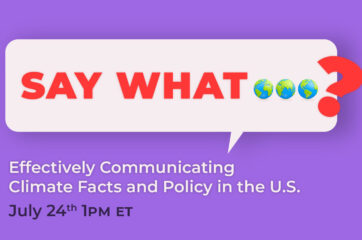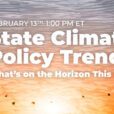As electrification efforts increase demand for energy in the U.S., oil and natural gas are likely sources to meet new energy needs — at least in the short-term. However, the extraction, transportation, and processing of oil and gas are collectively the largest industrial source of methane emissions in the country. As methane is far more potent than carbon dioxide (and responsible for around a third of human-induced warming), it’s essential that states have strong and ambitious policies to limit pollution from this fossil fuel.
In December the U.S. EPA released their final rule for oil and gas operations, which includes New Source Performance Standards that reduce pollution from new or reconstructed fossil fuel sources, and Emissions Guidelines that help states develop plans to limit methane emissions.
We invited a panel of experts to explore what the new EPA rule means for ambitious climate policy at the state level and highlight existing state approaches to regulating methane. Our panelists included Jon Goldstein, Senior Director, Regulatory & Legislative Affairs at EDF; Barry Rabe, Professor of Environmental Policy, University of Michigan’s Gerald R. Ford School of Public Policy; and Kayley Shoup, Citizens Caring for the Future, a grassroots organization working on reducing methane emissions in New Mexico.
In this recap article, we’ll provide highlights from our expert panel’s presentations, including an exploration of state and federal methane regulations for the oil & gas sector, the current context of methane in larger discussions of climate policy, and the impact of community-led groups in shaping state methane regulations from the ground up.
Jon Goldstein, EDF
Jon Goldstein is Senior Director of Regulatory & Legislative Affairs at EDF. He leads EDF’s efforts to improve regulation of the oil and gas industry and protect air and water resources at the state and federal level. His areas of expertise include state oil and gas policy, climate policy, and federal lands.
Methane Emissions from the Oil & Gas Industry
Methane is a big challenge — it’s 84 times more potent than carbon dioxide in the short term, and it has caused 25 percent of man-made global warming — but that also makes it a big opportunity. Oil & gas (O&G) is the largest industrial source of methane emissions in the U.S., as methane is the primary constituent of natural gas. Methane from O&G production is emitted alongside volatile organic compounds (VOCs), a building block of ozone pollution — methane emissions are a public health, climate, and waste problem.
One of the major sources of methane emissions from O&G in the U.S. is older, smaller, “marginal” wells. Although these small wells only constitute six percent of U.S. O&G production, they account for 50 percent of well-site emissions. Another major source is malfunctioning flares. Flaring is the widely-used practice of burning natural gas that is emitted during oil extraction, and EDF surveys have found that 1 in 10 flares were malfunctioning or unlit. These malfunctions can lead to methane gas leaks — in fact, aerial remote sensing finds that flares constitute 12 percent of detected emissions.
EDF’s findings support what environmental justice groups have voiced for years, which is that historically marginalized communities across the country — such as communities of color, older Americans, children, and those living below the federal poverty line — live near wells in greater proportions than other demographic groups in their same county.
State and Federal Methane Regulations
State Methane Rules
Two states leading the charge on methane regulation are Colorado and New Mexico, whose bans on routine venting and flaring, requirements for frequent leak detection and repair, and other pollution-reducing measures from O&G wells have served as a model for federal methane regulation recently finalized by the U.S. Environmental Protection Agency (EPA).
EPA’s Final Methane Rules
The EPA announced their final rules aimed at reducing methane emissions from O&G in December 2023 at COP28. Key requirements include:
- Comprehensive, frequent leak monitoring requirements for all wells
- A protective, sector-wide zero pollution standard for pneumatics, which traditionally allow for small methane emissions while regulating the temperature and pressure of gas emitted by the well
- Strengthened flaring provisions that require new sources to eliminate routine flaring within two years of the rule’s finalization.
The EPA estimates that these standards will reduce methane from covered sources by 80 percent by 2038, with total methane emissions reductions estimated at 58 million tons. To put it into perspective, in 2030 alone, the expected emissions reductions are equivalent to taking 28 million gas-powered cars off the road.
In terms of actual implementation, states will be responsible for adopting federally-aligned policies for their existing O&G sources of methane pollution. The EPA allows states to submit a State Implementation Plan (SIP) in the next two years that meets or exceeds EPA’s guidelines. If a state does not submit a SIP, or if the EPA finds the SIP unacceptable, the state will be subject to a Federal Implementation Plan (FIP) from EPA to ensure those sources are covered.
The Inflation Reduction Act’s Methane Emissions Reduction Program (MERP)
The Inflation Reduction Act (IRA) established the Methane Emissions Reduction Program (MERP), which complements and reinforces the aforementioned EPA rules with market-based mechanisms. EPA recently released their proposal for implementing MERP, including establishing a waste charge for large polluting facilities in the O&G sector with excessive methane pollution. For companies that don’t meet industry-aligned targets, they must pay a fee per ton of methane — however, they can avoid this fee if they are in compliance with their state’s SIP. MERP also includes over $1.5 billion in funding to reduce methane emissions, available to state and tribal agencies, communities, and producers themselves.
Barry Rabe, Ford School at University of Michigan
Barry Rabe is the Arthur Thurnau Professor of Environmental Policy at the Gerald Ford School of Public Policy at the University of Michigan. He is also a Non-Resident Senior Fellow at the Brookings Institution. Barry is a political scientist who studies the political feasibility and durability of climate and environmental policy, particularly in federal systems such as the United States and Canada.
The “Methane Moment”: the U.S. Context of Methane Policy
Although federal methane regulation is stepping up now, methane is not a new issue. In the 1950s, Texas began efforts to regulate flaring, and in the 1980s, in the Bakken, North Dakota tried to alter the tax code to include methane in the state’s high severance taxes on O&G production. However, methane has only recently made a move from relative obscurity toward the center of discussions around climate change, which had previously focused more on carbon dioxide — methane was even a prominent theme of recent COP28 discussions, much more so than in previous years.
The O&G industry accounts for around 30 percent of total U.S. methane emissions, and as O&G will continue to be produced at a fairly significant rate — last year, Canada and the U.S. produced more O&G than the entire Middle East, with the U.S. claiming a spot as the world’s leading exporter of liquefied natural gas (LNG). Of course, this means that methane also presents an opportunity for the U.S. to act as a global leader.
The EPA’s recent final rules and MERP proposal present a relatively unique approach for reducing greenhouse gas emissions in the country, through a combination of regulatory tools alongside other measures related to pricing, subsidies, and disclosure — one which has not been used for carbon dioxide.
What’s Next on Methane Regulation?
This federal approach was certainly shaped by innovative models implemented at the state level by Colorado and New Mexico. However, implementation of the EPA’s regulations may prove to be a big challenge in other O&G production states, due to a combination of issues with staffing shortages, regulatory capture, and enthusiasm for working on climate issues.
Beyond the O&G sector, an important next step is diffusing the same ideas behind regulating methane emissions toward other sectors, such as coal, solid waste landfills, agriculture, and livestock, which make up about 70 percent of U.S. methane emissions.
Kayley Shoup, Citizens Caring for the Future
Kayley Shoup is an organizer with Citizens Caring for the Future (CCFF), a grassroots and frontline-led climate advocacy group in the Permian Basin. Upon seeing the impacts of the Permian oil boom on public health in her community in 2019, her passion for environmental activism was truly awakened. She began working with CCFF in 2020 and feels incredibly grateful to know and work with other concerned citizens, grassroots activists, and environmental stewards in the Permian and the state of New Mexico.
The Impact of Grassroots Advocacy in New Mexico
Citizens Caring for the Future (CCFF) is one of the only, if not the only, community-led group working in the environmental and climate advocacy space in the Permian Basin, which is the most active oil-producing field in the country, spanning southeast New Mexico and west Texas. CCFF was started during a retreat in 2019 led by Interfaith Power and Light and Earthworks in southeast New Mexico, where community members were able to record and see invisible methane emissions with a specialized camera. A group of retreat participants from the city of Carlsbad, NM got together after the retreat to discuss what they had learned, and found that many of their concerns around air quality, health, housing costs, traffic, and more were shared amongst community members — from this group, CCFF was born.
CCFF’s first action was speaking in support of strong methane regulation at a hearing organized by the NM Environment Department during the creation of the state’s methane rules. CCFF continued being heavily involved in the rulemaking process until their passage in 2022, which required all operators to capture 98 percent of produced natural gas by 2026 and prohibited routine venting and flaring.
Methane as an Environmental Justice Concern
These regulations tackled a huge environmental justice issue, as New Mexico is 53 percent people of color, with approximately 80,000 people living within a half mile of O&G wells. Aside from the Permian Basin, NM is also home to the San Juan Basin in the northwest corner of the state, an area with a large Native American population — 17 percent of whom live within a half mile of an O&G facility.
While reducing methane emissions is often discussed within the context of curtailing climate change, methane also presents a major local health issue. Methane is emitted alongside harmful pollutants like volatile organic compounds (VOCs) such as benzene, a known carcinogen, and while New Mexico has strong methane regulations, the neighboring state of Texas does not, and emissions don’t know borders — a truth that harms New Mexicans regardless of their own state’s actions. The new EPA rules, then, present an opportunity to reduce these EJ issues across state lines while spurring job creation and involving communities in imagining a cleaner future.
Recommendations for CPRG Implementation Grant Applications
After states have submitted their PCAPs, they must submit their Implementation Grant application, aiming to fund a portion of the PCAP’s identified measures. As these Implementation grants are competitive, states should prioritize the following to set themselves up as best they can:
- Transform a single economic sector, while linking together opportunities and prioritizing innovation
- Collaborate with other states and develop regional approaches
- Fill gaps to unlock additional federal funding
- Prioritize disadvantaged communities
- Support high-quality, good-paying jobs
- Enact and advance supportive and ambitious state policies:
- Increased clean electricity standards
- New transportation electrification commitments and incentive programs
- Zero-emission appliance standards for space and water heating and all electric building codes
- Industrial facility emissions standards
Conclusion
Recent federal developments in regulating methane emissions are a quintessential example of state policy shaping federal agendas to create effective, broad-sweeping climate policy. However, this is only the start — implementing the EPA’s methane rules across the country will require broad coalitions that recognize methane not only as a contributor to climate change but also as a major threat to local public health. As with much of the ambitious climate policy in the state-level climate policy arena, the fight starts from the ground up, and empowering frontline communities as decision makers is critical to ensuring an equitable implementation. Alongside our national network of state climate actors, we can ensure that we keep our momentum in this “methane moment” — and co-create sustainable, effective, and just climate policy.
* The views and opinions expressed by our guest speakers during the webinar and summarized in this article are their own and do not necessarily reflect the views or positions of Climate XChange.








